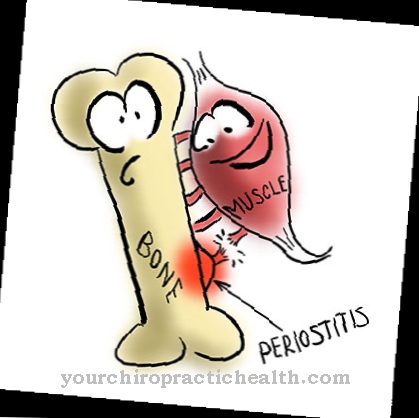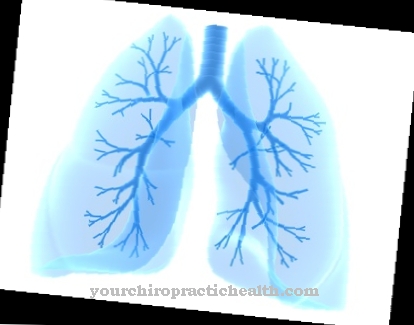Ebola or that Ebola fever is an infectious disease that causes a high fever and can lead to internal bleeding. The infection is caused by the Ebola virus and can be transmitted from person to person.
What is Ebola?
Ebola was first documented in Central Africa in the 1970s. In the case of the hemorrhagic form of Ebola, the mortality rate is particularly high: three out of four patients die from internal bleeding.
The tropical disease was named after the African river of the same name on which the disease first appeared. The occurrence of Ebola is limited to central Africa. However, there have also been isolated cases of Ebola outside of Africa, all of which can be traced back to a previous stay of the persons concerned in the corresponding areas of Africa.
Ebola occurs time and again in localized epidemics in which there are several hundred infected people, about half of whom survive the disease.

causes
The cause of the Ebola disease belongs to the group of viruses that cause hemorrhagic fever, including also include the yellow fever and dengue viruses. The group of the Ebola virus also includes the Marburg virus, which was responsible for the death of several scientists in Marbug in 1967 who were infected with the Ebola-like virus in the laboratory of African monkeys.
It is therefore assumed that primarily monkeys, but also rodents, bats and insects are carriers of the dangerous Ebola virus. The viruses can also be transmitted to humans by eating sick animals. The transmission from person to person takes place through body fluids such as blood, body secretions or simple smear and droplet infections.
It has been observed that only patients in the acute phase of the disease are contagious. Patients do not transmit the Ebola virus in the incubation period before the onset of the disease and after recovery.
Symptoms, ailments & signs

If you are infected with Ebola, the first symptoms appear after two to 21 days. The main symptoms of the disease include headache and body aches as well as nausea and [[vomiting] 9. Patients experience a growing [[loss of appetite] 9, which relatively quickly leads to [[weight loss
This usually accompanies a high fever, which manifests itself as chills, sweats and other typical symptoms. An outward sign is the typical rash that first appears in the neck area and can spread to the entire back, chest and arms. In the course of the Ebola infection, the kidneys and liver may malfunction.
Just a few days after the onset of the disease, severe internal and external bleeding occurs, which particularly affects the mucous membranes. The symptoms can occur in the gastrointestinal tract, eyes and other organs and are usually accompanied by an increasing feeling of illness. In the later stages, the individual organs fail.
Physical decline usually begins in the liver and kidneys and ends in the brain and heart. In addition, inflammation of the brain can occur. If the course is severe, signs of septic shock appear. These are associated with severe circulatory problems and the risk of secondary infections.
Diagnosis & course
The time between infection and the outbreak of Ebola can be between 5 and 20 days. Suddenly high fever, chills, severe headache, sore throat and body aches are the first symptoms of Ebola. The flu-like symptoms often do not immediately suggest Ebola.
Later on, stomach cramps, vomiting and diarrhea occur. The severe hemorrhagic form leads to coagulation disorders of the blood and consequently to internal and external bleeding. Ebola sufferers bleed visibly from all mucous membranes such as eyes, mouth and in the genital area. Then there is the dangerous internal bleeding, especially in the stomach and intestinal tract.
The loss of blood leads to shock, circulatory collapse and multiple organ failure, from which the patient in most cases dies.
When Ebola is diagnosed, the virus is found in the patient's blood, urine, saliva, or tissue samples. Usually the territorial origin of the patient or a previous trip to the relevant areas of Africa gives an initial indication of the presence of Ebola.
Is there a danger for Germany, Austria & Switzerland?

In general, you cannot answer the question with a yes or no. Theoretically, there is a small risk that travelers and refugees from Africa will also introduce Ebola to Central Europe.
The Hamburg virus expert Jonas Schmidt-Chanasit from the Bernhard Nocht Institute for Tropical Medicine said in this regard: "Due to international air traffic, it is possible that such a case will be imported to Germany. But there will never be an outbreak like that in West Africa. Our health system and our cultural requirements are completely different."A safety procedure is the so-called "exit screening" already in the risk countries. Passengers who want to fly to Europe are examined for epidemics, Ebola fever and other symptoms. If it is suspected that the traveler has become infected, an onward flight will be refused.
Apart from Brussels Airlines, there are currently no European Union airlines flying to the Ebola countries Liberia, Guinea and Sierra Leone. This also minimizes the immediate danger for Germany, Austria and Switzerland (as of October 2014). However, more and more refugees from Africa are arriving in Europe by land or the Mediterranean. Here the risk of the disease being introduced is greater and more unpredictable.
In Germany there are a number of hospitals and clinics with special isolation wards for patients with highly contagious diseases such as Ebola. For example in Hamburg, Berlin, Frankfurt am Main, Düsseldorf, Leipzig, Stuttgart, Würzburg and Munich.
In the worst-case scenario, larger cities would initially be at risk, as their airports make them a hub for travelers and refugees from Africa. Infection through droplet and smear infection could then also be possible in underground and suburban trains. Sparsely populated areas such as Mecklenburg-Western Pomerania, the Bavarian Forest, Hunsrück, Eifel, Emsland and the high Alps have an extremely low risk of Ebola spreading.
Should there still be a chain infection in Germany, the federal government could declare a state of emergency with the help of the Infection Protection Act (IfSG) and forcibly isolate and treat infected people to protect them from the rest of the population.
Due to the modern medical training of doctors and the excellent medical infrastructure in Europe, there is a very low risk of a mass epidemic with the Ebola virus, in contrast to many poor countries in Africa. World Bank President Jim Yong Kim recently put this very radically: "Thousands of people are dying of Ebola in Africa because they were unfortunately born in the wrong place in the world."Conclusion: Even if some people in Germany should contract the Ebola virus, the chances of survival are good.
Complications
Ebola is usually a very serious viral infectious disease. The Ebola virus that causes the disease is one of the most dangerous viruses known to date. The illness usually begins harmlessly with flu-like symptoms.
Patients often complain of headaches and body aches. The first complications in the form of high fever, nausea and vomiting appear very soon. Skin rashes and conjunctivitis are also seen regularly. Often there is also a disorder of kidney and liver function.
Blood tests regularly show low platelet and white blood cell counts in those affected. After a few days, in addition to the other symptoms, severe internal and external bleeding occurs, which mainly affects the mucous membranes. The eyes and gastrointestinal tract are primarily affected, but other organs can also be attacked.
As the disease progresses, various organs often fail, particularly the kidneys, liver, spleen, and lungs. Another complication is an inflammation of the brain. In addition, secondary bacterial infections of the skin or lungs often occur. In the case of severe disease, a kind of septic shock also occurs regularly. The patients in these cases often die of heart failure.
When should you go to the doctor?
If symptoms such as fever, chills, headache, sore throat, muscle pain, and loss of appetite are noticed, it may be Ebola. Anyone who experiences these symptoms one to three weeks after traveling to a risk area may have become infected and should consult a doctor. A medical clarification is also necessary if the symptoms mentioned do not subside after two to three days at the latest. Should internal and external bleeding occur, the nearest clinic must be consulted immediately. Likewise, if side effects such as stomach cramps or diarrhea occur.
If an Ebola infection is left untreated, it inevitably leads to shock and ultimately to circulatory collapse or heart failure. If no doctor has been called in by then, the emergency services must be alerted immediately. In the meantime, first aiders should provide first aid and inform the emergency doctor about the symptoms when they arrive. Basically, however, Ebola should be clarified and treated as soon as it first appears. Anyone who has a specific suspicion must immediately discuss this with the family doctor and, if necessary, go directly to inpatient treatment.
Doctors & therapists in your area
Treatment & Therapy
So far there is no Ebola-specific treatment. Only the symptoms of the disease are treated, especially the bleeding disorders associated with the hemorrhagic form of Ebola in order to stop the internal and external bleeding.
Inpatient treatment in the isolation ward is also an important measure to prevent further spread of the virus. As the hygienic conditions in most African hospitals are poor, local epidemic-like outbreaks often occur.
The high mortality rate of Ebola sufferers in Africa is mainly due to the late diagnosis and start of treatment as well as inadequate treatment options.
Outlook & forecast
The prognosis for infection with an Ebola pathogen is generally very poor. The mortality rate is between 30 and 90 percent. The lethality depends on the type of pathogen. The chances of survival and recovery also improve somewhat with immediate medical emergency help.
However, there is no causal therapy. The body has to deal with the virus itself. However, this can be supported by symptomatic therapy. This treatment consists in stabilizing the water and electrolyte balance in the organism. In this way, the fatal courses caused by dehydration can be reduced.
The greatest danger for the organism, however, is the extensive bleeding in the internal organs. Depending on the intensity of the bleeding, multiple organ failure is very common. There is currently no therapy that can stop the bleeding during the acute phase of the infection. If the immune system manages to fight the pathogen before organ failure, there is a good chance of a complete cure.
It has not yet been possible to conclusively clarify whether immunity against the pathogen will then be developed. However, it is assumed that there is immunity to the respective pathogen for at least a few years. The greatest risk of infection is during the illness. After the symptoms have subsided, the patients are usually no longer contagious. However, the virus is found in the semen months after the infection, so that it can be transmitted long after the illness in the event of sexual contact.
prevention
An effective method such as drugs or vaccinations to prevent Ebola does not yet exist. The first experimental Ebola vaccines are to be tested in Africa in 2015. Scientists, however, are working hard to identify the main carrier of the Ebola virus. Only then can effective prevention take place with targeted measures by avoiding contact with this particular carrier.
Approximately 2500 Ebola cases have been counted since 1976, of which about half of the patients survived the disease. Since the main distribution areas in the Central African Congo, the Ivory Coast, Uganda and Gabon are not tourist destinations, a distribution outside of Africa was not to be expected until summer 2014.
However, in connection with the 2014 Ebola fever epidemic, two infected Americans were flown to the United States and treated further. A Spaniard was also flown to Spain for closer examination and therapy. On August 19, 2014, a woman in Berlin suspected of having Ebola was quarantined in the isolation ward of the Berlin Charité. Instead of Ebola, however, the woman suffered from malaria, as it turned out the next day.
The Federal Foreign Office of the Federal Republic of Germany has therefore advised against traveling to West Africa since August 1, 2014. The World Health Organization (WHO) also declared the Ebola epidemic an international emergency.
Aftercare
The measures or options for aftercare are severely limited in most cases of Ebola. The disease must first and foremost be treated by a doctor as quickly as possible in order to prevent the death of the person concerned. Self-healing cannot occur and the symptoms of the disease intensify enormously if there is no treatment.
For this reason, Ebola focuses on the early detection and treatment of the disease so that there are no further complications. The person affected should isolate themselves in any case and not come into contact with other people. This is the only way to prevent further infection. Treatment is usually done by taking medication.
It is important to ensure the correct dosage and regular intake in order to alleviate internal bleeding and other complaints. Even after the symptoms have subsided, medical examinations of the internal organs should be carried out in order to identify and treat damage. The life expectancy of those affected is significantly reduced by Ebola if the disease is recognized and treated late. Further follow-up measures are usually not necessary.
You can do that yourself
Ebola is an acutely life-threatening infectious disease. Due to the severity of the disease and the risk of infection, patients must under no circumstances try to control the treatment themselves.
People suffering from Ebola must seek medical attention immediately after the first symptoms. For this reason, there are hardly any options for patients to help themselves with the disease. The focus is on the doctor's instructions, especially with regard to the intake of medicinal active ingredients.
Probably the only measure for those affected is to stop physical activity as much as possible in order to give the body rest and not to increase the feeling of physical weakness. Avoiding movement is almost the only measure that patients can influence. All other treatment decisions are made by the responsible doctors.
In order to reduce the risk of infection for other people, the patients strictly adhere to the quarantine measures and under no circumstances try to defy corresponding instructions. Otherwise, they acutely endanger the lives of other people. In addition, the patients take all prescribed medication, such as fluid replacement for diarrhea symptoms or medication for internal bleeding. They usually receive adapted meals or infusions.













.jpg)

.jpg)
.jpg)











.jpg)